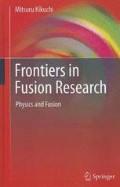Abstract
The motion of light and objects in nature follows an orbit in which the path integral of the “action” becomes extremal. Fermat’s well-known optics principle tells us that light draws an orbit such that the time required becomes minimum between fixed point A and B. For example, Snell’s law describing refraction of light in media with different refractive indexes can be derived from Fermat’s principle (Figure 4.1). Nature is governed beautifully by the variational principle.
The variational principle for the object motion is expressed by Hamilton’s principle. The complex charged particle motion, a combination of Larmor and drift motions in the confinement magnetic field, can be simplified using the above variational principle.
Access this chapter
Tax calculation will be finalised at checkout
Purchases are for personal use only
References
Goldstein H (1950) Classical Mechanics. Addison-Wesley.
Courant R, Hilbert D (1989) Methods of Mathematical Physics Vol. 1 Wiley-Interscience.
Landau LD, Lifshitz EM (1994) Classical Theory of Fields 4th edn. Pergamon Press.
Alfven H. (1940) Ark. Mat., Astron. Fys. 27A, 22.
Littlejohn RG (1983) J. Plasma Phys 29, 111–125.
Morozov AI, Solovev LS (1966) Rev. Plasma Phys., 2, 201.
Boozer A (2004) Rev. Mod. Phys., 76, 1071–1141.
Taylor JB (1964) Phys. Fluids, 7, 767–773.
Fowler RH, et al. (1985) Phys. Fluids 28, 338.
Boozer A and Kuo-Petravic G (1981) Phys. Fluids, 24, 851–859.
Kulsrud RM (2005) Plasma Physics for Astrophysics. Princeton University Press.
Littlejohn RH (1982) J. Math. Phys., 23, 742–747.
Cary JR, Littlejohn RG (1983) Ann. Phys., 151, 1–34.
Hasegawa A (2005) Physica Scr. T116, 72–74.
Yoshida, Z, et al. (2010) Phys. Rev. Lett., 104, 235004.
Flanders H (1989) Differential Forms with Applications to the Physical Sciences. Dover Books.
Brizard AJ, Hahm TS (2007) Rev. Mod. Phys., 79, 421–468.
Hahm TS (1988) Phys. Fluids, 31, 2670–2673.
Author information
Authors and Affiliations
Rights and permissions
Copyright information
© 2011 Springer
About this chapter
Cite this chapter
Kikuchi, M. (2011). Charged Particle Motion: Lagrange–Hamilton Orbit Dynamics. In: Frontiers in Fusion Research. Springer, London. https://doi.org/10.1007/978-1-84996-411-1_4
Download citation
DOI: https://doi.org/10.1007/978-1-84996-411-1_4
Publisher Name: Springer, London
Print ISBN: 978-1-84996-410-4
Online ISBN: 978-1-84996-411-1
eBook Packages: EngineeringEngineering (R0)

